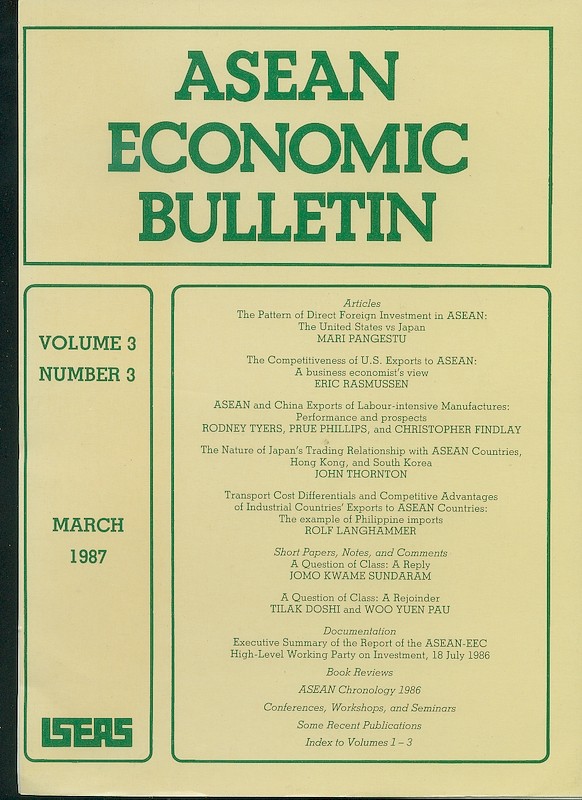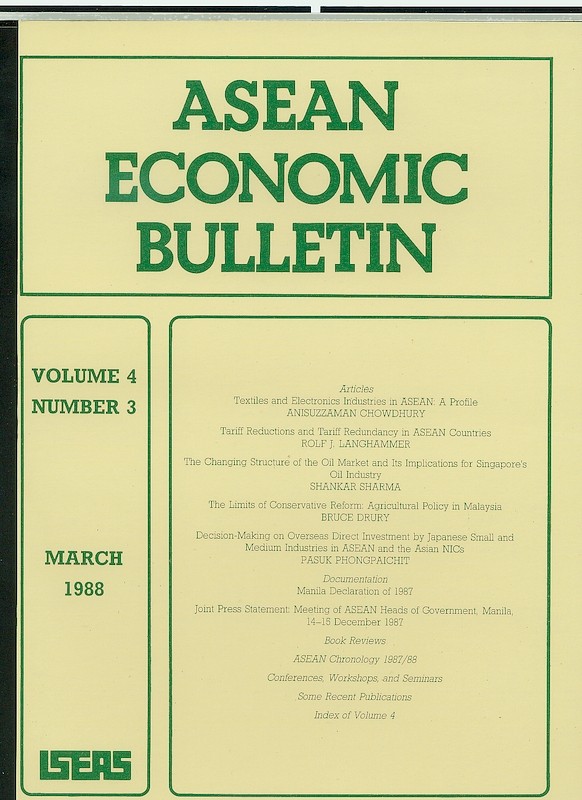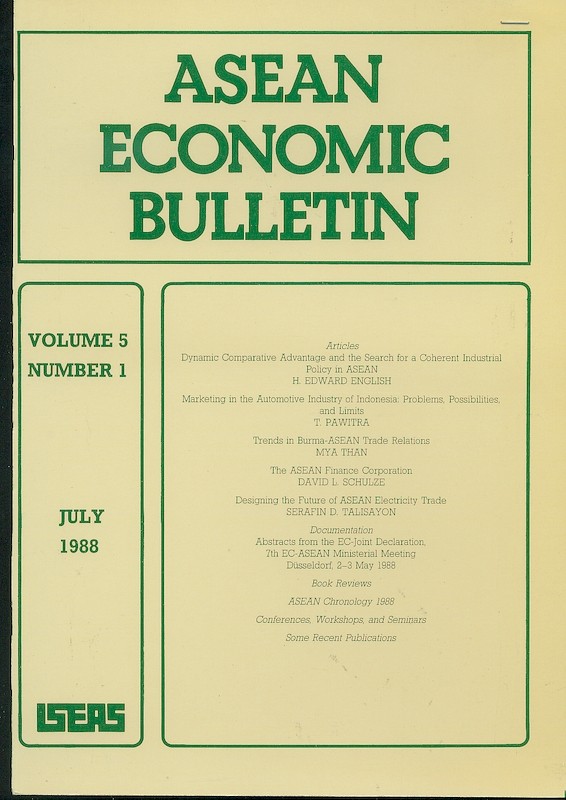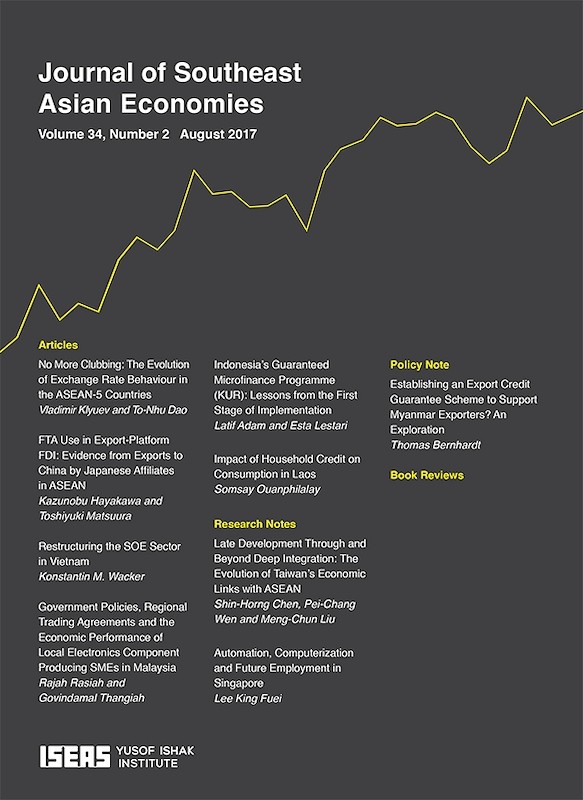ASEAN Economic Bulletin Vol. 3/3 (Mar 1987)

Date of publication:
March 1987
Number of pages:
128
Code:
AE3/3
Contents
-
Preliminary pages
- ARTICLES
-
The Pattern of Direct Foreign Investment in ASEAN: The United States vs Japan, by Mari E Pangestu, author see abstractThis study utilizes investment-intensity indexes to explain and analyze the pattern of direct foreign investment from Japan and the United States into the ASEAN region. Two broad sets of determinants can be hypothesized to affect the intensity of bilateral investment flows between any two countries: First, complementarity in the industry structure of direct investment flows which is influenced by relative factor and resource endowments as well as government policies: Second, country bias factors such as geographical proximity, and historical and institutional ties which enhance or decrease the locational attractiveness of the host country. The analysis indicates that country bias factors were more important in explaining the higher levels of intensity of investment between Japan and ASEAN compared with the United States and ASEAN, as well as changes in the levels of intensity.
-
The Competitiveness of U.S. Exports to ASEAN: A Business Economist's View, by Eric Rasmussen, author see abstractThe business managers perception of economic competition is often markedly dissimilar from the conceptual abstraction of the theoretical economist. This article outlines those aspects of competition and competitiveness which the business professional would consider important, particularly with respect to export markets. It then examines the competitiveness of U.S. exports to ASEAN, employing both macro- and micro-level trade data in a statistical analysis. The analysis seems to suggest that the United States continued to maintain a relatively good position in exports to ASEAN through the 1970s. Its position is probably even stronger if trade in invisibles is taken into account.
-
ASEAN and China Exports of Labour-intensive Manufactures: Performance and Prospects, by Rodney Tyers, Prue Phillips, Christopher Findlay, authors see abstractThe ASEAN countries and China have substantially increased their exports of labour-intensive manufactures (LIM) in the last two decades and the emergence of China as an exporter of manufactures in the eighties will present the ASEAN exporters with increasing competition in the future. The present paper examines the hypothesis that ASEAN may be crowded out of world LIM markets by China. It first presents and analyses the available data on commodity composition and country distribution of ASEAN and Chinese LIM exports and then examines the respective patterns of comparative advantage and considers the likely future impact of China's entry into world LIM trade on ASEAN development. In the final analysis education and work-force skills will be decisive factors in future developments, and the most important ASEAN exports are likely to be manufactures and services that are relatively intensive in human capital and technology rather than labour-intensive.
-
The Nature of Japan's Trading Relationship with ASEAN Countries, Hong Kong, and South Korea, by John Thornton, author see abstractJapan's trading relationship with the ASEAN countries and two of the East Asian NICs (Hong Kong and South Korea) is examined. Indices of revealed comparative advantage, trade intensity, complementarity, and market access are presented, and symmetry in trade analyzed. The study concludes that the bilateral trading relationship between Japan and the Asian economies is disproportionately large (although decreasing), and that revealed comparative advantage based on a broad commodity classification is insufficient as an explanation of the intensity of trade. Instead, the intensity of trade would seem to be related to geographic proximity, market familiarity and, in some cases, direct foreign investment.
-
Transport Cost Differentials and Competitive Advantages of Industrial Countries' Exports to ASEAN Countries: The Example of Philippine Imports, by Rolf J Langhammer, author see abstractDo differences in transport costs due to varying geographic locations significantly influence the direction of trade flows? By comparing Japanese exports to the Philippines with those from the United States and Japan, this paper investigates whether Japan owes part of its outstanding export performance in ASEAN markets to its locational advantage. The analysis of the empirical evidence suggests that other factors, for example in the realm of production technology and marketing, are more important in explaining Japan's competitiveness.
-
SHORT PAPERS, NOTES, AND COMMENTS: A Question of Class: A Reply, by Jomo K Sundaram, author
-
SHORT PAPERS, NOTES, AND COMMENTS: A Question of Class: A rejoinder, by Tilak K Doshi, Woo Yuen Pau, authors
-
DOCUMENTATION: Executive Summary of the Report of the ASEAN-EEC High-Level Working Party on Investment, 18 July 1986
-
BOOK REVIEWS: Barriers to Trade in Banking and Financial Services, by Ingo Walter, by Lee Tsao Yuan, author
-
BOOK REVIEWS: How Commodity Futures Markets Work, by Basil S Yamey, Richard L Sandor and Brian Hindley, by Lim Kim Lian, author
-
BOOK REVIEWS: Export-oriented Industrialization: The ASEAN Experience, by Mohamed Ariff and Hal Hill, by Ng Chee Yuen, author
-
BOOK REVIEWS: A Course through Life: Memoirs of an Australian Economist, by H W Arndt, by Hans Christoph Rieger, author
-
ASEAN Chronology 1986
-
Conferences, Workshops, and Seminars
-
Some Recent Publications
-
Index to Volumes 1-3 (1984-87)






